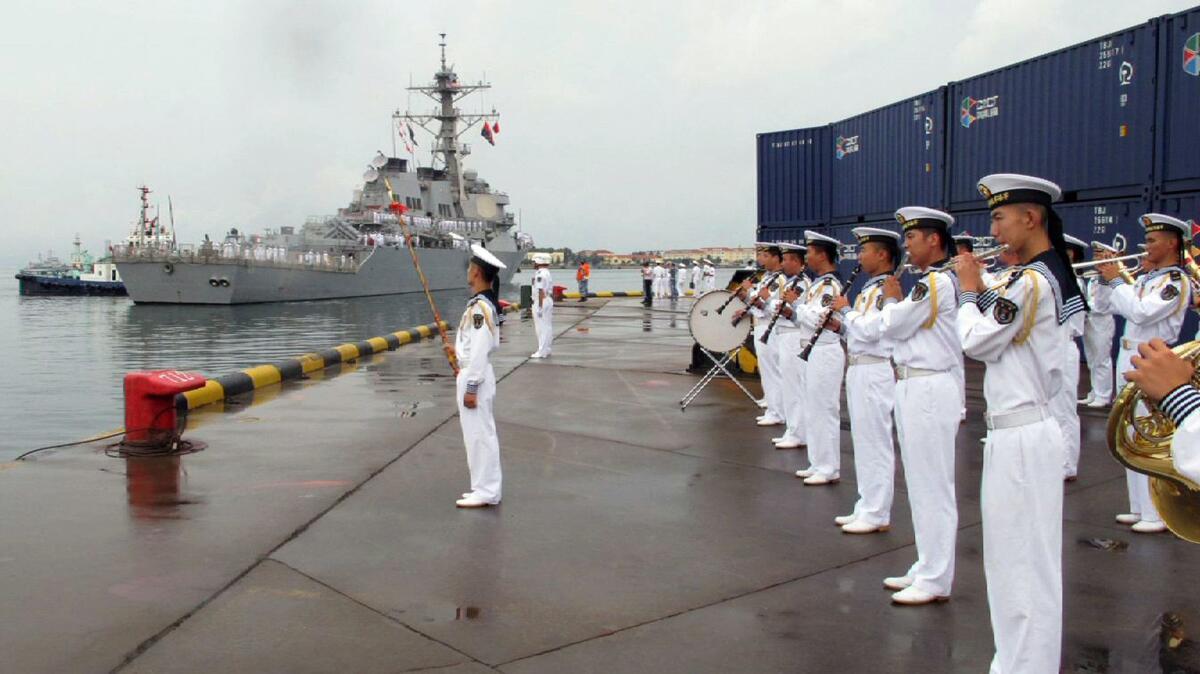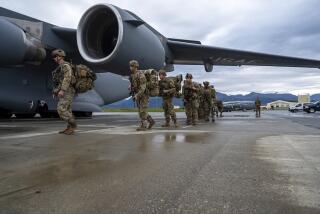U.S. warships pass near Taiwan in a show of defiance to China

- Share via
Reporting from HENGCHUN, Taiwan — Two U.S. warships passed through the strait separating Taiwan from China, shining new attention on improving Taipei-Washington relations despite Chinese irritation.
The upbeat announcement of the ships’ passage Saturday came from Taipei, rather than Washington, which analysts said was an obvious sign of cooperation between the two governments over the maneuvers.
For the record:
4:50 p.m. July 8, 2018An earlier version of this article misspelled the name of the university where Alexander Huang is a strategic studies professor. It is Tamkang University, not Tamang.
“It could be to send a signal to outsiders or to Beijing indicating that Taiwan has maintained very close ties with the U.S. military,” said Andrew Yang, a Taiwanese former defense minister who is secretary-general of the Chinese Council of Advanced Policy Studies think tank.
Yang noted that U.S. ships transited the Taiwan Strait a year ago this month, but Taiwan wasn’t immediately aware.
Taiwan’s Foreign Ministry announced that the guided missile destroyers Mustin and Benfold moved northbound Saturday through the 100-mile-wide strait.
The U.S. Navy’s Indo-Pacific Command operation in Honolulu said Friday that the Mustin had passed through the South China Sea just south of the strait but did not mention later movement into the strait on Saturday. It did not mention the Benfold.
The Taiwanese government’s statement on the ships contained just two lines and did not say how Taiwan knew about the ships. It said the Foreign Ministry “will cooperate with the security departments of other countries.”
It appears the U.S. and Taiwanese militaries did not officially work together on the ships’ passage. A Taiwanese Defense Ministry spokesman said Taiwan picked up the ship movements by radar.
Still, the right to announce the movements is a “privilege” for Taiwan, said Alexander Huang, a strategic studies professor at Tamkang University in Taiwan.
The United States has sent ships into the South China Sea at least seven other times under President Trump to show it considers the waterway an international one. China calls 90% of the sea its own and has landfilled a handful of islets for military use. Beijing conducted military drills in the sea this year.
The Benfold, however, visited a port in China two years ago to help build trust between the two militaries. The 22-year-old vessel supports antiaircraft missiles, and it can conduct anti-submarine warfare.
Passage of the warships follows a tightening of U.S.-Taiwan bonds over the last six months despite resentment in China. U.S. legislation finalized in March encourages more senior-level U.S.-Taiwan visits, for example, and Washington openly opposes Chinese demands that 44 international airlines quit referring online to Taiwan as a “country.”
U.S. Navy movements in the Taiwan Strait are nothing new, though they are rare. In 2007, a U.S. aircraft carrier sailed through the strait on its way to home port in Japan, a route Washington described then as a safety move due to weather. Even so, China expressed “grave concern” over the passage.
American vessels made their way through the strait in 1996 as Taiwan prepared for its first direct, democratic presidential election after a Chinese missile test in the strait. Then-secretary of State Warren Christopher accused China of “intimidation and coercion” against Taiwan. China alleged foreign intervention by Washington in its affairs.
As of early Sunday, China had made no response to the ships’ passage via its flagship state-run media or the Foreign Ministry in Beijing.
China normally fumes about such ship movements because Washington recognizes Beijing instead of Taipei diplomatically. Beijing sees self-ruled Taiwan as breakaway Chinese territory and resents the United States for maintaining informal relations.
Beijing is likely to protest but in a “pro forma” way as U.S. ship movements off East Asia are “becoming regular behavior,” Yang said.
Taiwan, militarily weaker than China and more diplomatically isolated, generally welcomes U.S. support. Some analysts in Taipei, however, say Trump is using Taiwan as a bargaining chip to pressure China on trade disputes.
China and Taiwan have been separately ruled since the Chinese civil war of the 1940s, when the Nationalists lost and fled to the island. China insists on eventual unification, though today’s democratically elected Taiwanese president opposes that aim.
China has flown military aircraft near the island a dozen times since 2015 and sent an aircraft carrier through the strait separating the two sides.
Taiwan’s Foreign Ministry said Saturday after the U.S. ship movements that it would “perfect its responsibilities as a regional player and jointly safeguard regional peace and stability.”
Jennings is a special correspondent.
More to Read
Sign up for Essential California
The most important California stories and recommendations in your inbox every morning.
You may occasionally receive promotional content from the Los Angeles Times.










